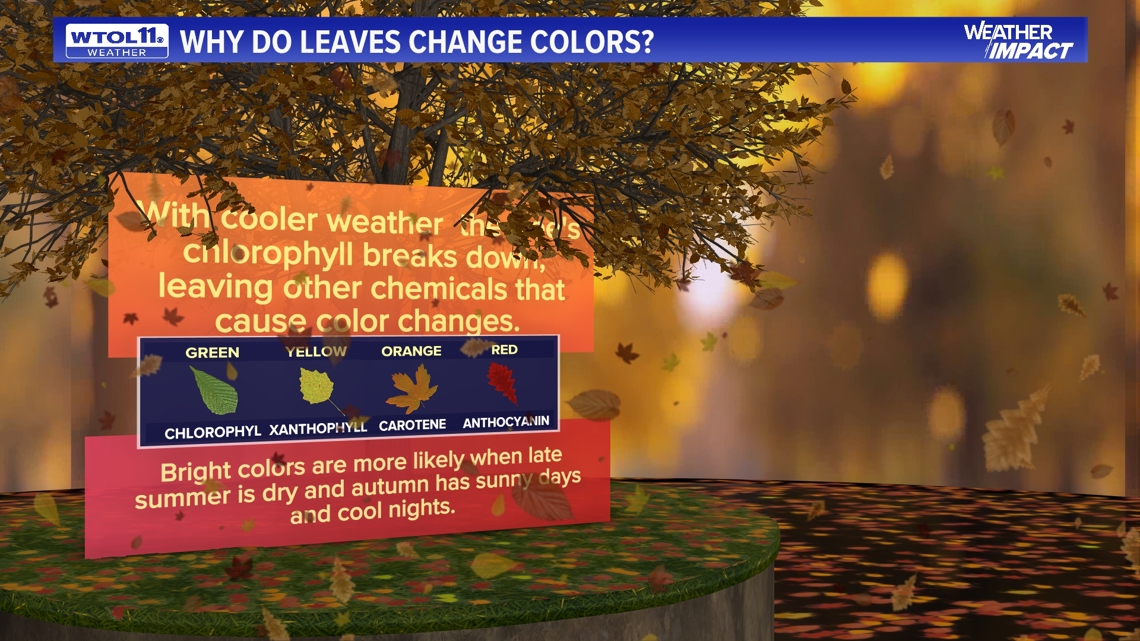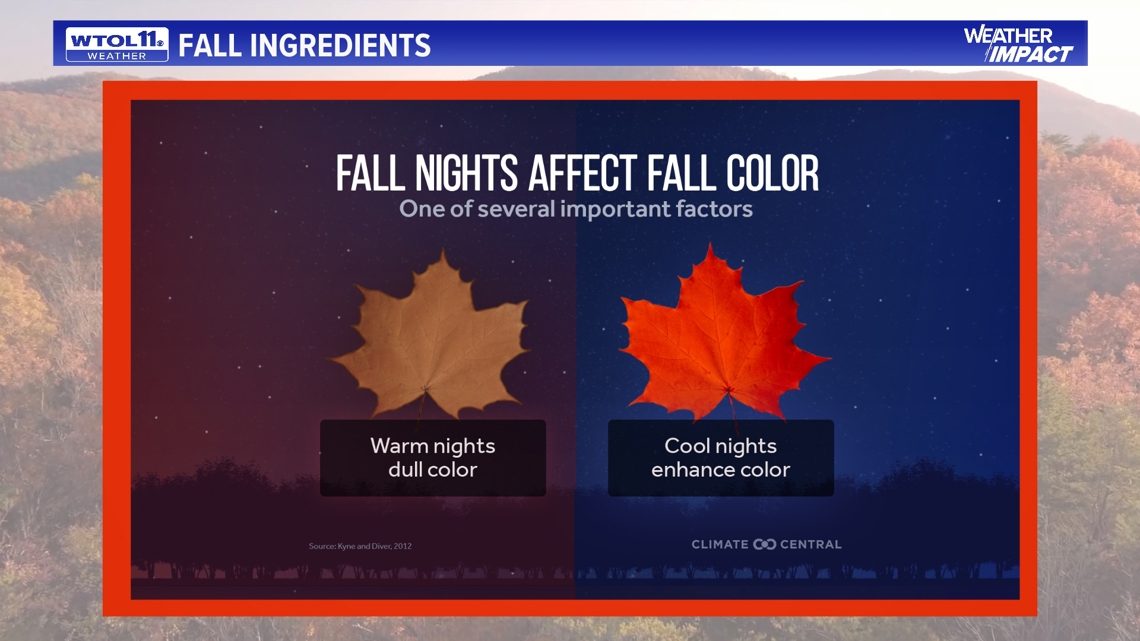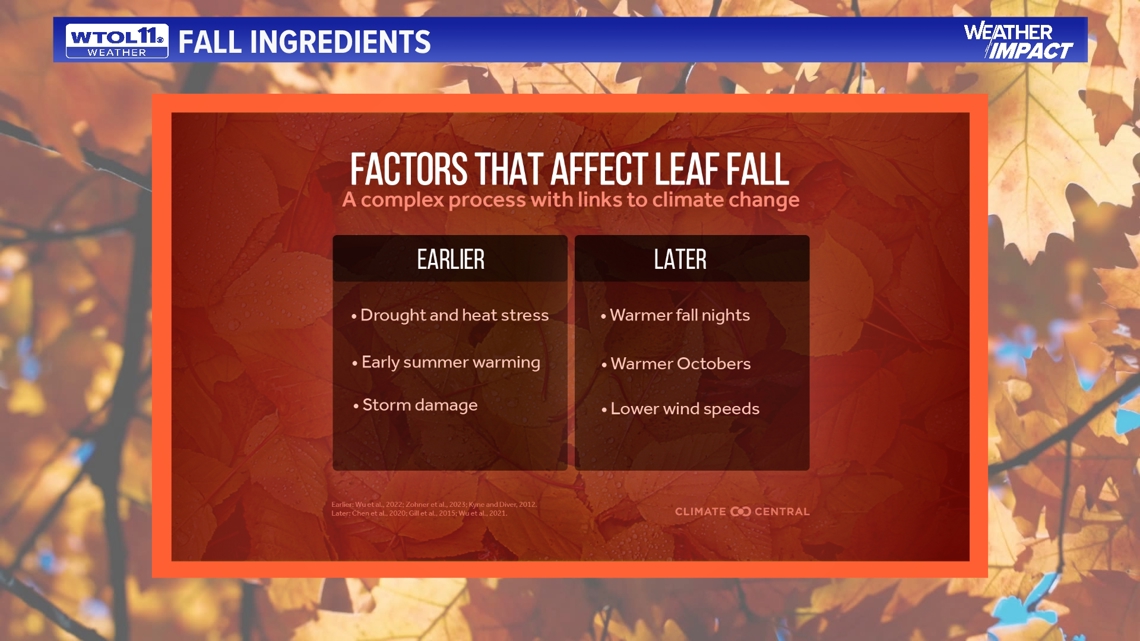TOLEDO, Ohio — The start of fall is finally here and the crisp, sunny feeling of the season will be in full effect throughout the next couple of months.
When you think of fall, the view of pumpkin patches, corn mazes and apple cider all come to mind. One thing we cannot forget to talk about when fall days arrive is the beautiful sights that truly make it feel like fall, and that is fall foliage.
If you are anywhere in the country, at some point your area will be filled with lush colors and vibrant greens, yellows and reds, truly bringing the fall feeling full circle.
Just like all species have a life cycle, so do trees and the leaves that make up a tree, but why during a certain time of the year do these leaves change color and then eventually fall off? Well to understand this, we must find the science behind why leaves change colors during the fall months.
In this week's WTOL 11 Weather Impact, we're breaking down how each season can be different with fall foliage, and how our recent conditions will impact fall foliage throughout northwest Ohio and southeast Michigan.


Why do leaves change colors?
It is time to go back to the classroom and learn the process of how the colors of leaves change, and why we get these specific colors instead of other colors.
According to the U.S. Department of Agriculture, during the growing season, chlorophyll is continually being produced and broken down and leaves appear green.
As night length increases in the autumn, chlorophyll (a green pigment used during photosynthesis) production slows down and then stops, and eventually, all the chlorophyll is destroyed. The carotenoids and anthocyanin in the leaf are then unmasked and show their colors.
The type of late summer and early fall depends on the type of season we would be expected to have based on the conditions.
Through September, we had extremely dry and above-average conditions. As a result, this led to a lot of trees prematurely changing colors and leaves changing due to the heat stress and lack of moisture within trees not having much with the lack of rain.
According to Climate Central Severe, drought and extreme heat can stress trees so that their leaves shrivel and turn brown before producing a colorful display. Many U.S. locations have experienced longer heat streaks and rising drought risks with warming.


Perfect ingredients for vibrant colors
One of the more important components of having great fall colors is having cool nights during the fall months. So, what exactly does this do for leaves?
According to Climate Central Shorter, fall days cue plants to ramp down photosynthesis for the season. This reduces chlorophyll, revealing orange and yellow leaf pigments that were previously masked by green.
At this stage, some species (such as red maples) start producing red or purple pigments, enhancing the vibrance of fall forests. The colder fall nights allow colors to truly stick out bringing brighter colors overall when the sun shines through.
The warmer night will be a muter dull color, like the color a leaf would look like when it is about to fall off the tree as a dead leaf.
Each area around the country has an idea and on average time of the year when they can expect peak colors typically. Some of the signs that show that colors are coming a bit earlier would be drought and heat stress.
This was a perfect example of what happened here in Ohio, where we had the heat and the impacts of drought turning trees before they were supposed to. The result of later fall foliage and peaks happening a lot later would be the characteristics of warmer fall nights. Above-average Octobers will drive the change as well.
Typically, we see the time of the year when cold fronts move in more often and sometimes these cold fronts can bring windy conditions, but if we do not get the brief cooldowns and the windy conditions from time to time, this will result in later peak colors ahead in years to come.
Warm and cold conditions are not the only thing at play here. We talked about drought being a factor too, but rain truly helps brighten those colors up.
Although rain is good, too much rain would again mute the colors to where they do not pop as much with the leaves still needed on those cooler crisp days.




Fall color impacts
The sad reality that comes with our warming climate is that it affects everything around us, especially the amazing colors of fall foliage.
We are continuing to see warmer conditions and records broken after records were just set. It has become the reality of warming conditions, especially overnight.
On average, temperatures have warmed almost five degrees since 1970, losing the fall chill we see overnight.
This year has been in the record books for drought conditions across Ohio. Many areas like southeast Ohio have seen extreme to exceptional drought conditions for a month now. Right here in Northwest Ohio, we have seen severe drought conditions and it is likely to continue well into October.
Above-average temperatures have played a huge role as well. The warmer conditions are not helping as much as we continue to struggle with warmer and dry weather headed more into October.
Over the years, on record, we are losing cooling days where the temperature is at or below average. This will result in less time we see fall foliage which will result in many areas and businesses being impacted by the lack of fall colors.





